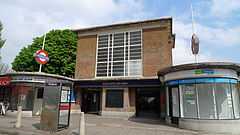Eastcote tube station
 | |
 Eastcote Location of Eastcote in Greater London | |
| Location | Eastcote |
| Local authority | London Borough of Hillingdon |
| Managed by | London Underground |
| Number of platforms | 2 |
| Fare zone | 5 |
| London Underground annual entry and exit | |
| 2009 |
|
| 2010 |
|
| 2011 |
|
| 2012 |
|
| 1904 | Tracks laid (Metropolitan) |
| 1906 | Opened (Metropolitan) |
| 1910 | Start (District) |
| 1933 | End (District) |
| 1933 | Start (Piccadilly) |
| 10 August 1964 | Goods yard closed[4] |
| Lists of stations |
|
|
| |
Eastcote is a London Underground station in Eastcote in north London. The station is on the Uxbridge branch of both the Metropolitan line and Piccadilly line, between Rayners Lane and Ruislip Manor stations. The station is located on Field End Road. It is in Travelcard Zone 5.

The Metropolitan Railway (Harrow and Uxbridge Railway) constructed the line between Harrow-on-the-Hill and Uxbridge and commenced services on 4 July 1904 with, initially, Ruislip being the only intermediate stop. At first, services were operated by steam trains, but track electrification was completed in the subsequent months and electric trains began operating on 1 January 1905.
Progressive development in the north Middlesex area over the next two decades lead to the gradual opening of additional stations along the Uxbridge branch to encourage the growth of new residential areas. Eastcote opened on 26 May 1906 as Eastcote Halt.[5]
On 1 March 1910, an extension of the District Line from South Harrow to connect with the Metropolitan Railway at Rayners Lane was opened enabling District Line trains to serve stations between Rayners Lane and Uxbridge from that date. On 23 October 1933 District Line services were replaced by Piccadilly Line trains. The station was rebuilt between 1937 and 1939[6] to a design by Charles Holden which features the large cube-shaped brick and glass ticket hall capped with a flat reinforced concrete roof and geometrical forms typical of the new stations built in this period.
The station is surrounded by the suburb of Eastcote; the original centre, now known as Old Eastcote is some distance away. The Cavendish Pavilion nearby was a popular destination for outings in the first part of the twentieth century.
Transport connections
Bus routes 282 and 398 serve the station.
References
- ↑ "Customer metrics: entries and exits: 2009". London Underground performance update. Transport for London. Retrieved 26 December 2012.
- ↑ "Customer metrics: entries and exits: 2010". London Underground performance update. Transport for London. Retrieved 26 December 2012.
- ↑ 3.0 3.1 "Multi-year station entry-and-exit figures" (XLS). London Underground station passenger usage data. Transport for London. 2013. Retrieved 22 July 2013.
- ↑ Hardy, Brian, ed. (March 2011). "How it used to be - freight on The Underground 50 years ago". Underground News (London Underground Railway Society) (591): 175–183. ISSN 0306-8617.
- ↑ Bowlt, Eileen. M (1989). 'The Goodliest Place in Middlesex'. A history of the Ancient Parish of Ruislip from the Domesday Book to modern times. Uxbridge: London Borough of Hillingdon. ISBN 0-907869-11-4.
- ↑ Bright Underground Spaces; David Lawrence; Capital Transport; London; 2008; p182
External links
| Wikimedia Commons has media related to Eastcote tube station. |
- Tube departure board for Eastcote station
- London's Transport Photographic Archive
- Eastcote Halt station, 1906
- Eastcote station, 1925 A group of children from the East End of London wait for a train to take them home from an excursion to the Pavilion.
- Eastcote station, 1933
- The Pavilion, 1933
- Eastcote station, 1949
- Eastcote station, 2001
| Preceding station | Following station | |||
|---|---|---|---|---|
towards Uxbridge |
Metropolitan line | |||
| Piccadilly line | towards Cockfosters |
| ||||||||||||||||||||||||||||||||||||||||||||||||||||||||||
| ||||||||||||||||||||||||||||||



